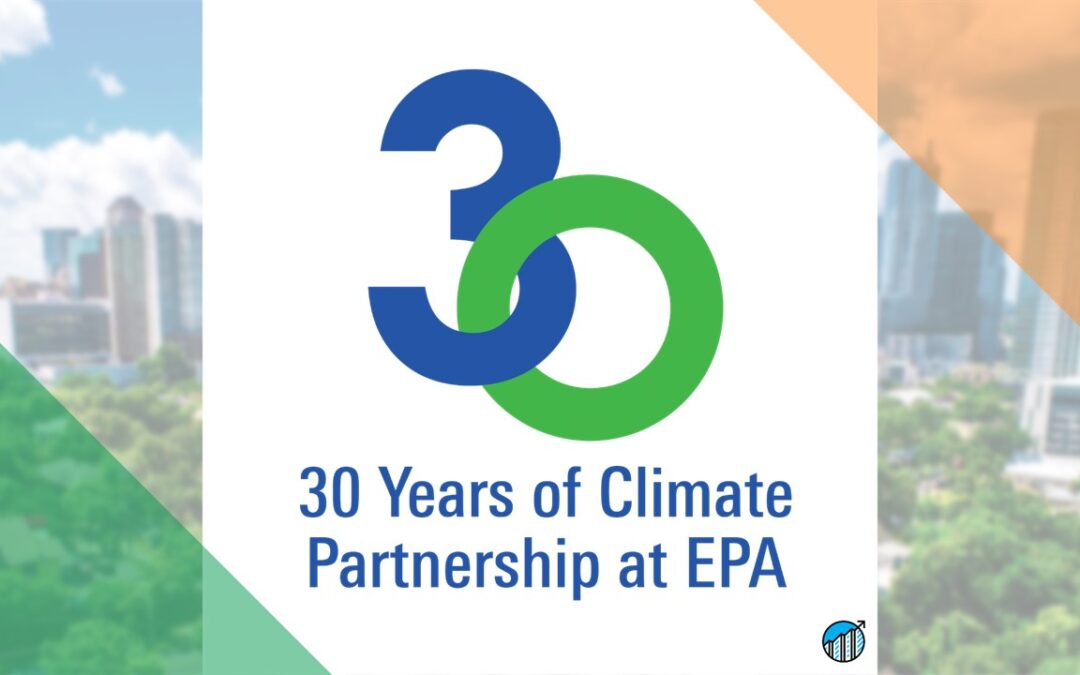
Aug 26, 2021 | Articles, Homepage
Dear Partners:
2021 marks a milestone celebration.
It was 30 years ago that an innovative idea took hold with the advent of the U.S. Environmental Protection Agency’s (EPA’s) Climate Partnership Programs. These voluntary programs serve to broaden and diversify the EPA’s climate approach—working hand-in-hand with private sector organizations and others to achieve more than would be possible through federal regulations alone.
As an ENERGY STAR supporter, Corporate Sustainability Strategies (CSS) invites you to join the celebration and to help spread the word about the cumulative impacts of the EPA’s Climate Partnership Programs.
Impact At-a-Glance
- More than 6 billion metric tons of greenhouse gas emissions have been prevented from entering our atmosphere
- American consumers and businesses have saved more than $500 billion.
- These programs drove reductions equivalent to 8% of total U.S. greenhouse gas emissions in 2019 alone.
Market Share and Impact on Commercial Real Estate
- Thousands of organizations, including 40% of Fortune 500 and 33 industrial sectors, partner with EPA to help advance energy efficiency.
- More than 270,000 commercial buildings (representing more than 25% of all commercial floor space in the U.S.) actively benchmarking energy use in ENERGY STAR Portfolio Manager to measure, track, and improve their energy performance.
- Compared to typical buildings, ENERGY STAR certified buildings drive investment in energy efficiency.
- Average Sale Price = up to 31% more
- Average Rental Rate = up to 16% more
At CSS, we know the business case for sustainability, and we believe in doing well by doing good.
It’s important to share how businesses, organizations, and communities are impacting climate change. We appreciate your dedication and continued partnership to strengthen our economies while improving lives and our planet.
Sincerely,
Brenna Walraven, BOMA Fellow, BOMI-HP®, CPM®, RPA®
President & CEO
Corporate Sustainability Strategies
Efficiency Pays. Always Has. Always Will.
Join EPA’s 30th Anniversary Celebration
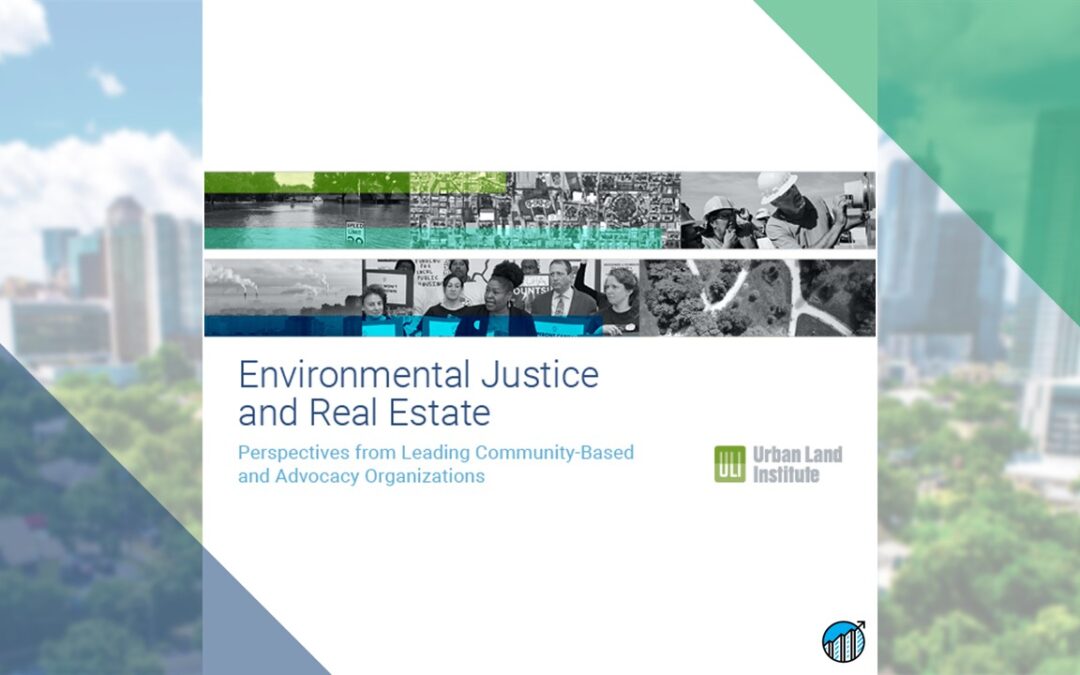
Aug 23, 2021 | Articles, Homepage
Environmental Justice and Real Estate: Perspectives from Leading Community-Based and Advocacy Organizations, a new publication released by the Urban Land Institute (ULI), explores the environmental justice movement and highlights the role real estate can play in contributing to sustainable, resilient, and equitable development, particularly through engagement and partnership with community organizations. Low-income communities and communities of color who contribute the least to environmental crises are often most at risk from climate or environmental hazards.
This publication features four interviews with community and advocacy organizations and thought pieces by ULI members that collectively provide insight into how real estate actors can support collaborative solutions and equitable built environments for all.
Read the full report on ULI’s Knowledge Finder.
About Urban Land Institute
ULI is a global, member-driven organization comprising more than 45,000 real estate and urban development professionals dedicated to advancing the Institute’s mission of shaping the future of the built environment for transformative impact in communities worldwide. ULI’s interdisciplinary
membership represents all aspects of the industry, including developers, property owners, investors, architects, urban planners, public officials, real estate brokers, appraisers, attorneys, engineers, financiers, and academics. Established in 1936, the Institute has a presence in the Americas, Europe, and the Asia Pacific region, with members in 80 countries.
Learn More
ULI’s Center for Sustainability and Economic Performance
ULI’s Urban Resilience Program
ULI’s Greenprint Center for Building Performance
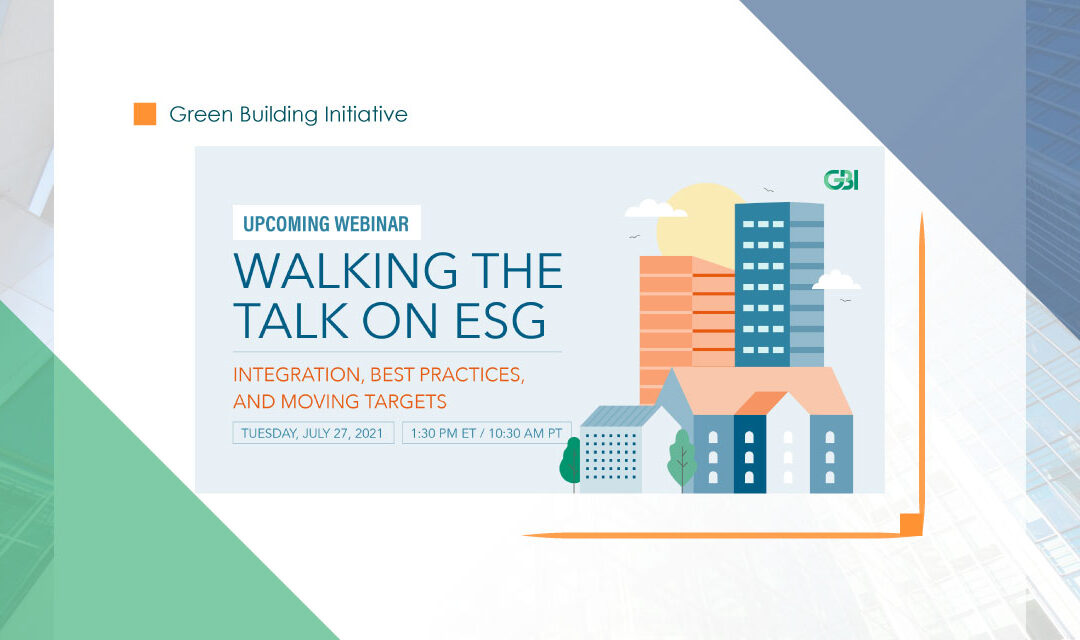
Jul 16, 2021 | Events
presented by Green Building Initiative
access recorded webinar here
Program
The Green Building Initiative, Inc. (GBI) is providing a 90-minute forum for information sharing on lessons learned from the perspective of those on the front lines in supporting ESG integration efforts within the buildings industry whether at a building, portfolio, organization, or policy-level. Four unique perspectives will be shared on the most compelling strategies and reasons for swift action on ESG integration.
Topics
Environmental Social Governance (ESG)
- Why are consumers, investors, and governments demanding ESG reporting?
- What constitutes an integrated approach to ESG?
- How are organizations and corporations developing strategies and KPIs around ESG?
- What are the implications for supply chains related to ESG and DEI?
- What lessons learned are emerging from those on the front lines of implementing ESG strategies?
- Where are the moving targets for those shepherding ESG strategies?
Expert Panel
- Vicki Worden, President & CEO, Green Building Initiative (host and moderator)
- Lotte Schlegel, Executive Director, Institute for Transformation
- Valentina Fomenko, PhD, Founder & CEO, Strategy DNA
- Brenna Walraven, President & CEO, Corporate Sustainability Strategies
When & Where
July 27, 2021
10:30AM-12:00PM PT
Virtual
Registration & More Information
GBI Webinar
Who Should Attend
- REIT representatives
- Investment fund managers
- Asset and property managers
- Building owners
- ESG managers
- Sustainability and ESG consultants
- Those writing or updating policies for facility management, vendors, and data collection
- State/provincial government employees
- Chief Sustainability Officers
- Chief Responsibility Officers
- Facility and energy managers
- Manufacturer representatives
- Ecommerce representatives
- Public affairs and government representatives
- Trend watchers
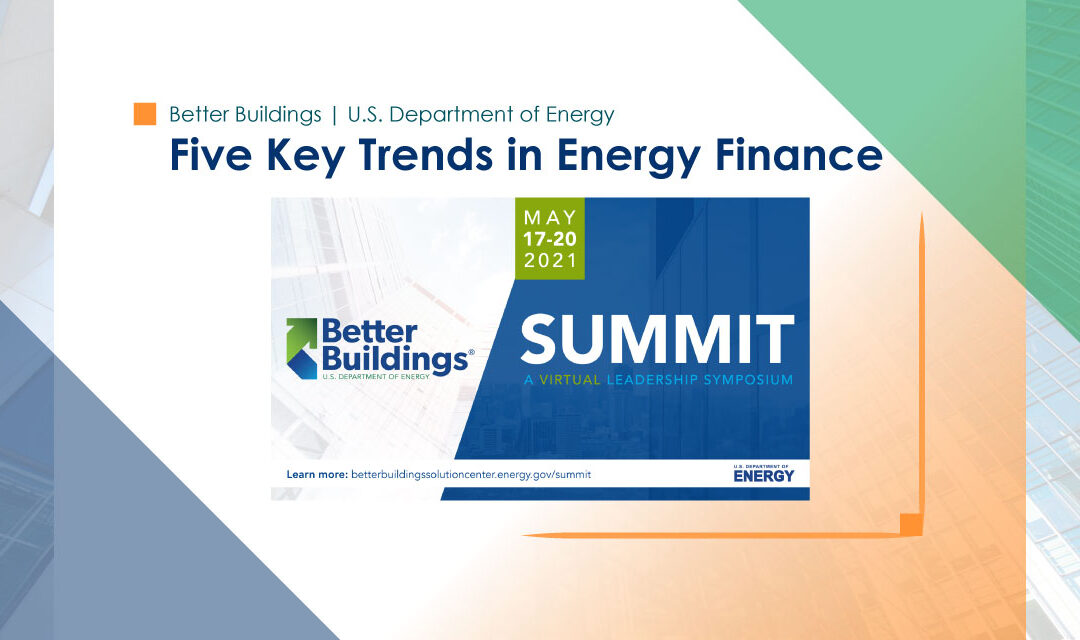
May 11, 2021 | Events, Homepage
presented by Better Buildings for U.S. Department of Energy
Program
The energy efficiency and renewable energy finance space is constantly adapting to new market developments and financing innovations. During this session, several market experts will weigh in on recent trends in several key financial products, including:
- How self-managed green revolving funds can help institutions recover and finance their energy efficiency/renewable energy retrofits after the pandemic;
- Expansion of efficiency-as-a-service into municipal, university, school, and hospital (MUSH) markets;
- Expansion of energy savings performance contracts (ESPC) into the commercial space;
- Green bond deployment trends; and
- Retroactive commercial PACE (CPACE) financing unlocking capital for businesses during the pandemic.
Speakers
- Donnel Baird, BlocPower
- Devesh Nirmul, Counterpointe SRE
- Mark Orlowski, Sustainable Endowments Institute
- Brenna Walraven, Corporate Sustainability Strategies
When & Where
May 18, 2021
2:00PM-3:15PM ET
Virtual Summit
Registration & More Information
2021 Summit Sessions | Better Buildings Initiative (energy.gov)
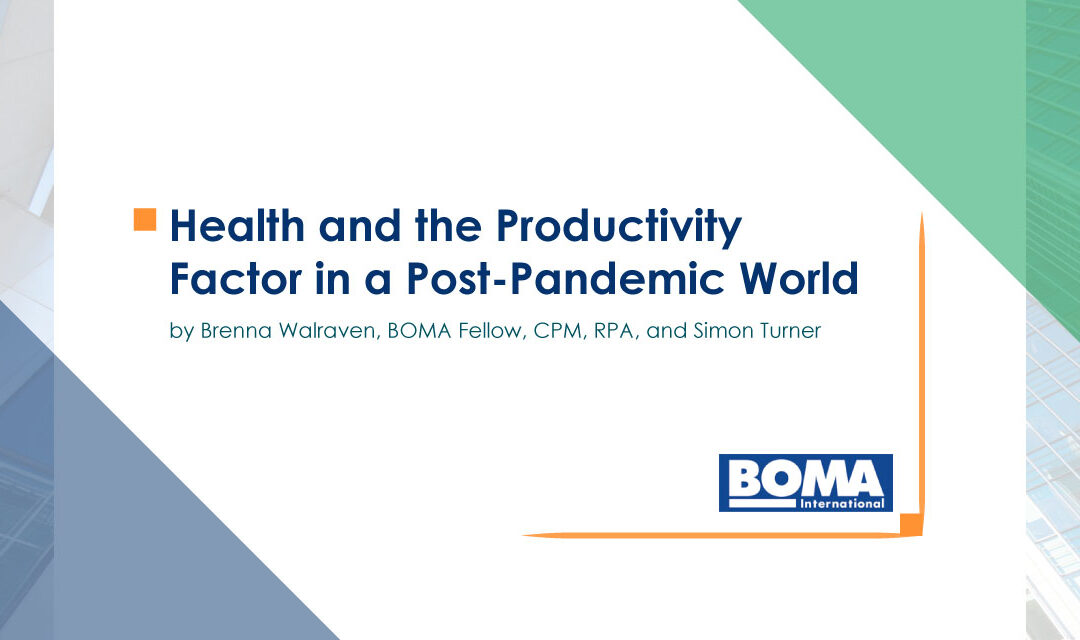
Apr 23, 2021 | Articles, Homepage
by Brenna Walraven, BOMA Fellow, CPM, RPA, and Simon Turner
Evidence of humankind’s long-standing battle against infectious diseases traces back thousands of years. There have been about 20 known pandemics in recorded history, and in some instances, they have led to an enhanced understanding of health and wellness issues and better approaches for safely navigating the world. The cholera epidemic that struck London in the mid-nineteenth century, for example, famously led to reforms in public water and sanitation systems. A decades-long campaign to distribute and socialize the use of mosquito nets has curtailed malaria. SARS, H1N1 and MERS were throttled by sophisticated pandemic control, including rapid behavioral changes, such as mask-wearing. Over the past 150 years, both the science of epidemiology and acceptance of disease control as a societal responsibility have come of age. Now more than ever, it’s clear that modern buildings must also contribute to life safety and health in the workplace.
As we prepare for a post-COVID-19 world, what practices will survive to confront pandemic preparedness in the future? Much has been written about remote work being here to stay, but the commercial real estate industry is banking on a basic human need for connection. The human species has evolved to congregate, and businesses know that ideas spring from being together, as in-person interactions spark creative thinking. It would be unwise to write off the office, but wise to reimagine its format.
Post-pandemic best practices will favor workplaces that create more space, higher ventilation rates—potentially even double the current ASHRAE minimums—and focus on how air is moved around buildings. Other changes will include open spaces, displacement ventilation, connections to the outside (both physically and via views), better lighting, more inviting stairwells, less reliance on elevators and more walkable spaces. For high-rise buildings, new elevator technology with vertical airflows and lower occupant density seems a sure bet, as is more touchless technology.
We can expect investments in buildings to respond to a market demand not just for COVID-free spaces, but healthier and more productive spaces. There is a great deal of research linking the factors that generate health and productivity in the workplace to substantial “bottom line” figures. Business owners are already familiar with utilizing financial analysis to make decisions, such as which space to lease. If building owners, property managers and leasing teams can discuss health-related features in these terms, they are likely to find a receptive audience.
The Fundamental Six
Listed below are six categories that are poised for growth in the post-pandemic workplace and what they mean for property professionals and tenants alike:
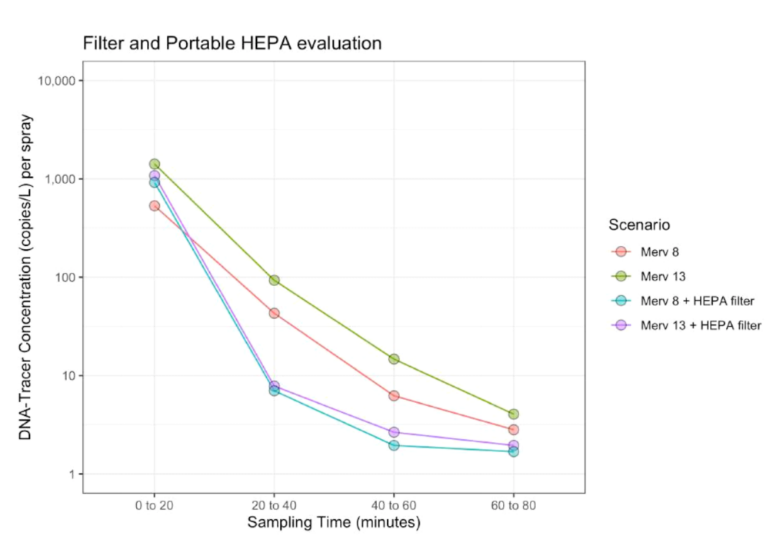
Releasing DNA-tracer virus surrogates into indoor air showed little impact from upgrading main filters—but significant improvements with standalone room filters. (Graph provided by SafeTraces™)
Indoor Air Quality
Indoor air quality (IAQ) is one of the leading building wellness buzzwords today—and for good reason. Tuning indoor air for the appropriate work environment creates one of the greatest opportunities for supporting both the cognitive and physical health of occupants, with an especially strong level of confidence.
Consensus is that ventilation is critical in the spread of the novel coronavirus. Physical barriers (i.e. masks) work because COVID-19 is spread via aerosols and droplets. It seems that wiping down surfaces might make occupants feel more comfortable—and that’s important, too—but contaminated surfaces, or fomites, are not the primary vector to worry about during this current pandemic.
While the science is still developing, studies are also emerging that indicate there may be little point in upgrading main filters beyond the MERV 11-13 range or using special technologies at the air handlers if your goal is to reduce viral numbers in the air traveling through the building. It is difficult for viral particles emitted by someone in a building to successfully travel to another room. Those particles will be:
-
- Mixed with and diluted by the immediate room air;
- Passed through the return system, diluted by all the other return air;
- Mixed with and diluted by outside air;
- Filtered twice, by media and then by wet cooling coils trapping and draining particles to condensate;
- Ejected through the supply fan;
- Divided at every junction in the supply duct system; and
- Exposed to another occupant for a fraction of a second as they walk through any remaining viral particles left in their breathing zone.
This should make building managers think twice before investing in expensive upgrades at their main air handlers, especially if they are already equipped with filters in the MERV 11-13 range.
Lighting and Views
Human beings evolved outdoors, in contact with nature, but today, we spend the vast majority of our time indoors. Generally speaking, people respond positively to light and green views. There is early research showing strong cognitive benefits of biophilia (connecting manmade environments to nature) and views to the outside. Having a window in the workplace has been shown to generate a six percent improvement in productivity. Circadian lighting (matching indoor light temperatures to the time of day) has shown significant sleep quality benefits and, in schools, double-digit increase in standardized test scores.
Thermal Comfort
Personalized thermal comfort has long been associated with productivity improvements. Building occupants may be growing less tolerant of fixed temperatures in their workplaces, and we will see a growing demand for adjustability in thermal environments. It is difficult to micromanage temperature to the individual level (versus room, suite or floor level), but temperatures in the low 70s Fahrenheit seems to produce the most productive workforce.
Noise and Sound
Productivity is eroded dramatically when we try to process multiple conversations. In the post-pandemic office, property professionals can expect tenant demands to include better control of distractions and interference, and a desire for variability depending on the worker and task at hand. Some tasks (and people) favor a high-energy space, but others require peace and quiet. This is a strong productivity factor that employers and their landlords should prioritize.
Active Design
The expectation that people should park themselves at a single workstation for the day may be a thing of the past. It is natural for people to seek variability in their workplaces depending on their moods, needs and type of work—and there are extended benefits of having access to movement and physical activity, even if only briefly. Future workplaces will provide more freedom to move, circulate and exercise.
Personal Fitness and Health
The pandemic has made people more aware of their own personal health and the impact of their surroundings. Products, services and training that address personal health will be in demand. Key factors for personal health include stress management, sleep hygiene, hydration, nutrition, exercise and resilience to infection and disease. Employers, property professionals and workspaces that support these needs can drive better outcomes for occupants, leading to enhanced satisfaction levels and improved tenant retention.
Running the Numbers
All of these elements offer potential productivity benefits to businesses, which can significantly improve their bottom lines. Science already exists to quantify these benefits. (Click here for a chart that provides an overview, courtesy of Simon Turner and Building Cognition LLC.)
While individual building results may vary, research shows the following potential for productivity gains from these elements:
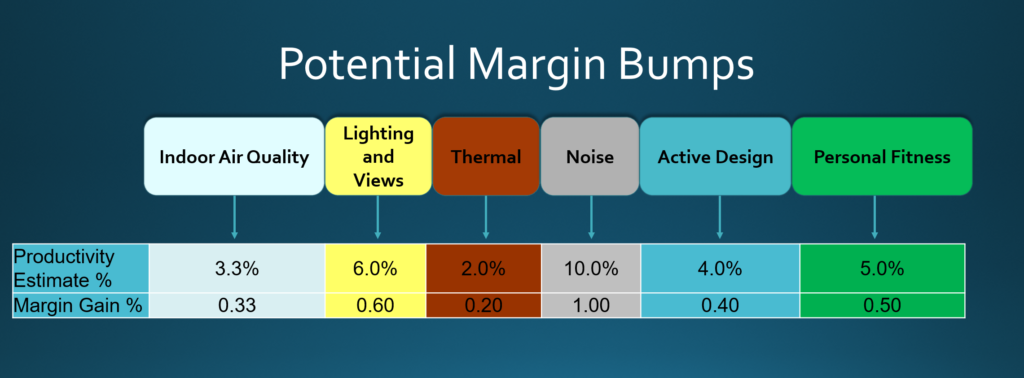
Margin gain assumption: Existing 10% margin (Courtesy: Simon Turner, Building Cognition LLC)
The exact impact for tenants will depend on the building’s environmental baseline: the existing ventilation rates, architectural details and—to a large extent—the existing tenant culture. By assessing potential for improved productivity, adapting the building’s appeal in key areas and marketing the correlation between productivity and margin gains to prospective tenants, commercial buildings can be much more attractive destinations. Done successfully, the building operator will become a true partner and trusted real estate advisor for the tenant.
Opportunity Awaits
There is great opportunity waiting on the other side of the COVID-19 pandemic. Owners and managers of commercial properties—and tenant decision makers—can emerge wiser, more educated and more technically adept at tackling the spread of disease. It all comes down to building management policies that prioritize ventilation, lighting, workplace choices and a culture of health and wellness. Property professionals and tenants should take a cue from recent events to implement fundamental building optimization practices that enable a healthier, more productive and more resilient workplace experience.
About the Authors
Brenna Walraven is the president & CEO of Corporate Sustainability Strategies, Inc. She also is a past chair of BOMA International. Simon Turner is the founder of Building Cognition LLC and a BOMA Life Member.
Original article posted at BOMA International.
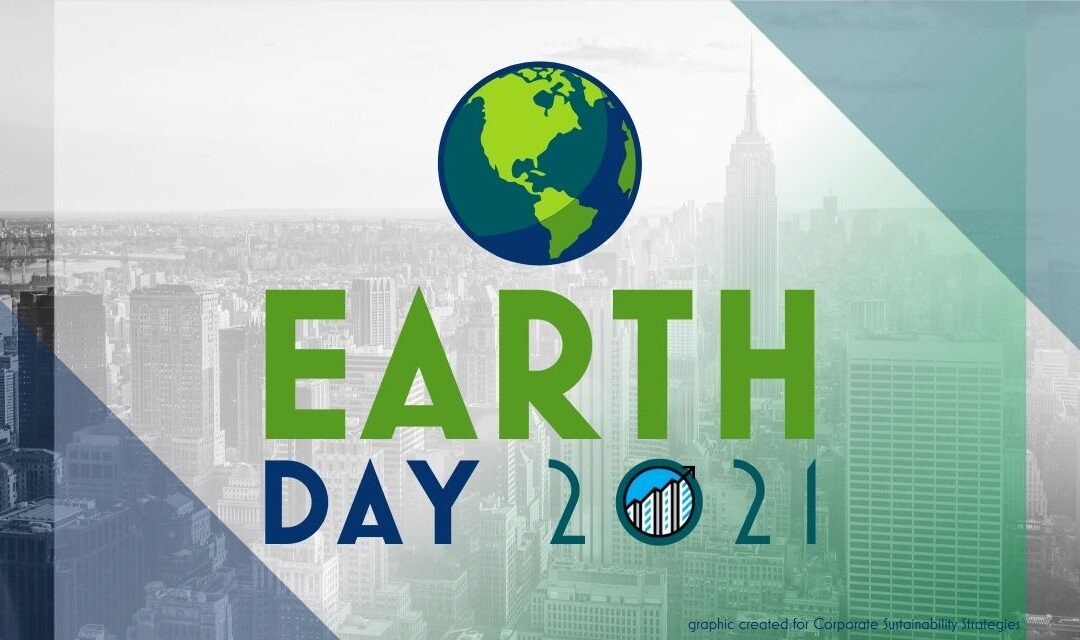
Apr 20, 2021 | Articles, Homepage
Today, 1 billion individuals in over 190 countries mobilize for action every Earth Day. World climate leaders, grassroots activists, nonprofit innovators, thought leaders, industry leaders, artists, musicians, influencers, and leaders of tomorrow are all involved.
On April 22, 2021, EarthDay.org is hosting its Earth Day Live digital event. The global show begins at 12 PM Eastern Time.
Restore Our Earth™ is Earth Day’s 2021 theme, which examines natural processes, emerging green technologies, and innovative thinking that can restore the world’s ecosystems.
Topics include:
- Climate and environmental literacy
- Climate restoration technologies
- Reforestation efforts
- Regenerative agriculture
- Equity and environmental justice
- Citizen science
- Cleanups, and more.
In celebration of Earth Day’s 51st Anniversary, here are 51 actions and tips to make a difference, every day of the year.
For more information on Earth Day visit www.earthday.org.








